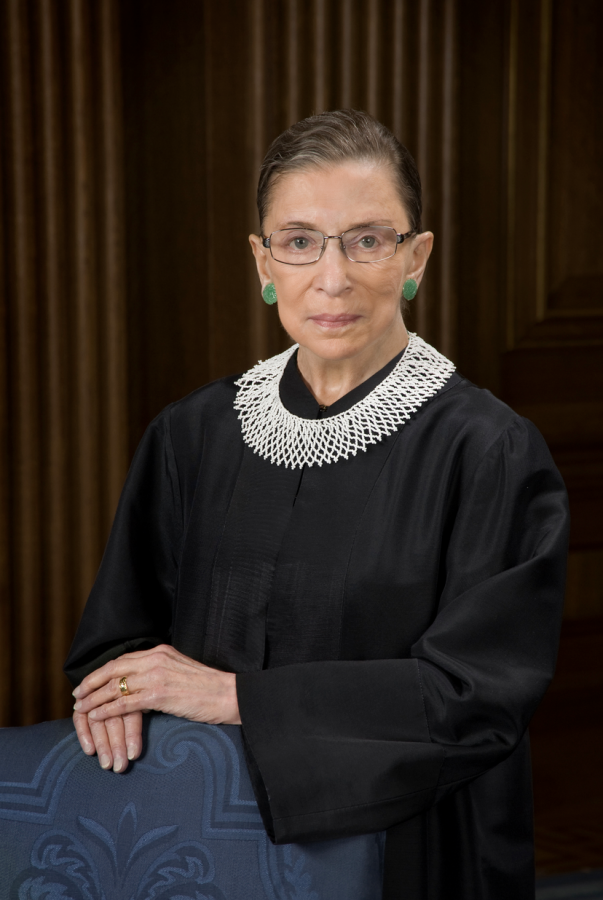Ruth Bader Ginsburg goes down in history
Loss of liberal icon could bring major shift in high court’s balance
Photo courtesy of The Collection of the Supreme Court of the United States
Ruth Bader Ginsburg was the second woman to serve on the U.S. Supreme Court. She died on Sept.18 at age 87.
Millions of American hearts sank last Friday upon hearing the news that Supreme Court Justice Ruth Bader Ginsburg had lost her two decade long battle with various cancers.
Ginsburg died of complications related to her recurring struggle with pancreatic cancer at the age of 87. She was the second female Supreme Court justice, serving on the nation’s highest court since 1993.
“Our nation has lost a jurist of historic stature. We at the Supreme Court have lost a cherished colleague,” Chief Justice John G. Roberts Jr. said in a statement the court released following Ginsburg’s death. “Today we mourn but with confidence that future generations will remember Ruth Bader Ginsburg as we knew her – a tireless and resolute champion of justice.”
With her absence, the power of the Supreme Court has shifted. There are currently five conservative justices and three liberal, in addition to the seat left vacant by Ginsburg.
The issue up for debate is whether President Donald Trump should be appointing her replacement about six weeks away from the Nov. 3 election after Republicans refused to even hold a hearing on then President Barack Obama’s nominee Merrick Garland during the last presidential election year.
In order for any nominee to be approved, the Senate needs a majority vote, with Vice President Mike Pence as the tiebreaker. Senate Majority Leader Mitch McConnell (R-Kentucky) has already shown his support for Trump appointing a new justice, just four years after denying President Obama from doing so in March 2016 because the election was eight months away.
Now, despite there only being six weeks before election day, McConnell seems to have reversed course on his earlier reasoning. Although the Nov. 2020 election is looming, this decision will play a big role for years to come. Supreme Court Justices serve for life, so many believe that the decision should be postponed until after the election so the American people get a say in who will fill Ginsburg’s robe.
Since Trump took office in January, 2017, he has appointed two other justices, Neil Gorsuch and Brett Kavanaugh. While no justice is bound by party constraints, if Trump were to appoint another justice, the court would be tilted more in favor of conservatives, six to three.
Though Trump has said that he plans on appointing a woman to replace Ginsburg – most likely Amy Barrett, a circuit judge on the U.S. Court of Appeals for the Seventh Circuit – it is speculated that the court may choose to overturn many landmark decisions including Roe v. Wade, which grants women the right to an abortion.
In her lifetime, Ginsburg was a fierce civil rights activist, and much of her work might be at stake if a conservative majority is formed.
Not only did she champion women’s rights, she also fought for the rights of many marginalized groups including disabled people and the LGBTQ+ community. Ginsburg was also a strong advocate of protecting the environment.
“Fight for the things that you care about, but do it in a way that will lead others to join you,” Ginsburg said at a Harvard luncheon in 2015 as advice to young women.
Though Ginsburg is now gone, her legacy will live on through the countless lives she touched throughout her inspiring lifetime. But only time will tell what will happen with her vacancy.
If the decision is postponed and Democrat candidate Joe Biden is elected president, he will then have the chance to nominate his own justice, restoring a conservative-liberal balance in the Supreme Court. But if Trump wins re-election or is able to make a decision prematurely, the conservative justices will be making decisions for all of America for decades to come.

Emmy Burrus is a senior at California High School, and is entering her third year of being a part of the Californian staff as Co Editor-in-Chief. Last...







